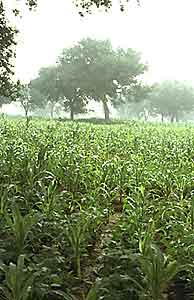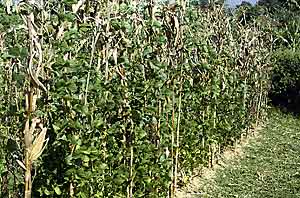Nutritional complementarities
- The beans provide a high protein food, and the corn a high energy food.
- The beans (and legumes generally) are rich in the essential amino acids that are deficient in corn (leucine and lysine), and corn is rich in amino acids that are deficient in beans (tryptophan and S-containing amino acids).
- Beans provide the vitamin niacin, which is very low in corn (low niacin in the diet results in a condition called Pellagra).
Ecological complementarities
The two crops, when grown together in a "polycropping" system are complementary ecologically as well:
- The corn provides stalks for climbing beans (photo below).
- The beans have nodules which fix nitrogen; corn consumes excess free mineral N in the soil, which stimulates more nitrogen fixation by beans, resulting in more N inputs to the system.
- The broad-leaf beans cover soil between the more vertically oriented corn, reducing habitats for weeds.
- Increased habitat heterogeneity increases the degree of regulation of pests by natural enemies.

Maize and beans in Burkina Faso
Beans are planted a few weeks after the maize to allow the maize to get a head start; note wide spacing of maize, beans cover ground between maize supressing weeds.

Maize and beans in Java, Indonesia
Maize has matured and been harvested; now the beans occupy the upper part of the canopy.